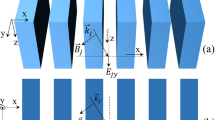Abstract
The behavior of light in dielectric gratings is discussed in terms of the optical Floquet-Bloch waves (or modes). The emphasis is on the development of a good physical understanding of the nature of these waves, using the wavevector diagram to summarize their spatial dispersion and spectra. It is shown that Floquet-Bloch theory offers some advantages conceptually over the commonly used coupled-wave theory, because the rays of the Floquet-Bloch waves (given by their group velocities) play the same role in a periodic medium as do those of plane waves in isotropic or graded-index media. The effect on power conservation of truncating the Floquet expansions for the Floquet-Bloch waves is considered in detail. Using the greater intuitive power of Floquet-Bloch theory, it is shown (in contrast to recent claims to the contrary) how rigorous coupled-wave theory can be applied to symmetrical reflection gratings, and secondly how the light in these gratings can be viewed in terms of the multiple-beam interference of Floquet-Bloch waves, leading to behavior reminiscent of a low-finesse Fabry-Perot cavity.
Similar content being viewed by others
References and Footnotes
See, for example: R.S. Chu, T. Tamir: Guided-wave theory of light diffraction by acoustic microwaves. IEEE Trans. MTT-18, 486–504 (1970), or
C. Elachi: Waves in active and passive periodic structures: A review. Proc. IEEE64, 666–1697 (1976)
L. Solymar, D.J. Cooke:Volume Holograms and Volume Gratings (Academic, New York 1981)
P.St.J. Russell: Phys. Rep.71, 209–312 (1981)
The process of tracing-back is actually more complicated than suggested in this simple discussion, although the basic idea is correct. The wavevector of then-th coupled-wave inside the grating is taken to be\(\bar k_n = \bar k_0 + nK\) where\(\bar k_0\) is the refracted wavevector of the incident wave, andK the grating vector. For each value ofn, a distinct coupled-wave is seen as existing inside the grating, and as giving rise to a discrete diffracted wave (possibly evanescent) outside the grating. Hence, one visualizes an external diffracted wave as arising from the coupled wave whose phase velocity parallel to the interface equals that of the external wave; the external wave is “traced back” into that coupled wave
R.S. Chu, T. Tamir: Proc. IEE (London)119, 797–806 (1972)
The excitation of single FB waves is possible in periodic planar waveguides using a prism coupler to launch a singlek 0 (or one of the higher order wavevectors of a FB wave) exactly in direction and magnitude. See: R. Ulrich, R. Zengerle: Optical Bloch waves in periodic planar waveguides, paper TuB1, Topical Meeting on Integrated and Guided-Wave Optics. Incline Village, Neveda (1980)
P.St.J. Russell, R. Ulrich: Elementary and coupled-waves in periodic planar waveguides. 2nd Europ. Conf. on Integrated Optics, Florence. IEE Conf. Publ.227, 88–91 (1983)
R.S. Chu, J.A. Kong: IEEE Trans. MTT-25, 18–24 (1977)
Z. Pinsker:Dynamical Scattering of X-Rays in Crystals, Springer Ser. Solid-State Sci.3 (Springer, Berlin, Heidelberg 1978)
C.V. Raman, N.S.N. Nath: Proc. Ind. Acad. Sci. Sect. A2, 406–420 (1935);3, 75–84 (1936)
H. Kogelnik: Bell Syst. Tech. J.48, 2909–2947 (1969)
R. Magnusson, T.K. Gaylord: J. Opt. Soc. Am.67, 1165–1170 (1977)
M.G. Moharam, T.K. Gaylord: J. Opt. Soc. Am.71, 811–818 (1981)
M.G. Moharam, T.K. Gaylord: J. Opt. Soc. Am.72, 187–190 (1982)
Z. Zylberberg, E. Marom: J. Opt. Soc. Am.73, 392–398 (1983)
P.St.J. Russell: Opt. Commun.48, 71–74 (1983)
F. Bloch: Z. Physik52, 555–600 (1928)
R.S. Chu, T. Tamir: Electr. Lett.7, 410–412 (1971)
I.M. Mason, E.A. Ash: J. Appl. Phys.42, 5343–5351 (1970)
P.St.J. Russell: Electr. Lett.20, 72–73 (1984)
This component is in fact the spatial average of 〈S〉, and points parallel to thegroup velocity. As is shown by Brillouin [26, 18], the directions of energy flow and group velocity in periodic media are not always identical
P.St.J. Russell: J. Opt. Soc. Am. A1, 293–299 (1984)
Notice that exactly the same travelling FB wave can be excited by a wide variety of different boundary conditions. The construction line in each case need only pass through a fixed intersection point (for example, either A or B in Fig. 5). Thus, exactly the same FB wave can be excited in a symmetrical reflection grating and in a symmetrical transmission grating if the construction line in each case cuts the curves in reciprocal space at the same point. This is a confirmation of the fact that the structure of the travelling FB waves dependsonly on the properties of the periodic medium itself, being independent of the boundary-geometry
M.G. Moharam, T.K. Gaylord: J. Opt. Soc. Am.73, 399–401 (1983)
M. Born, E. Wolf:Principles of Optics (Pergamon, Oxford 1980) Sect. 7.6
L. Brillouin:Wave Propagation and Group Velocity (Academic, New York 1960)




